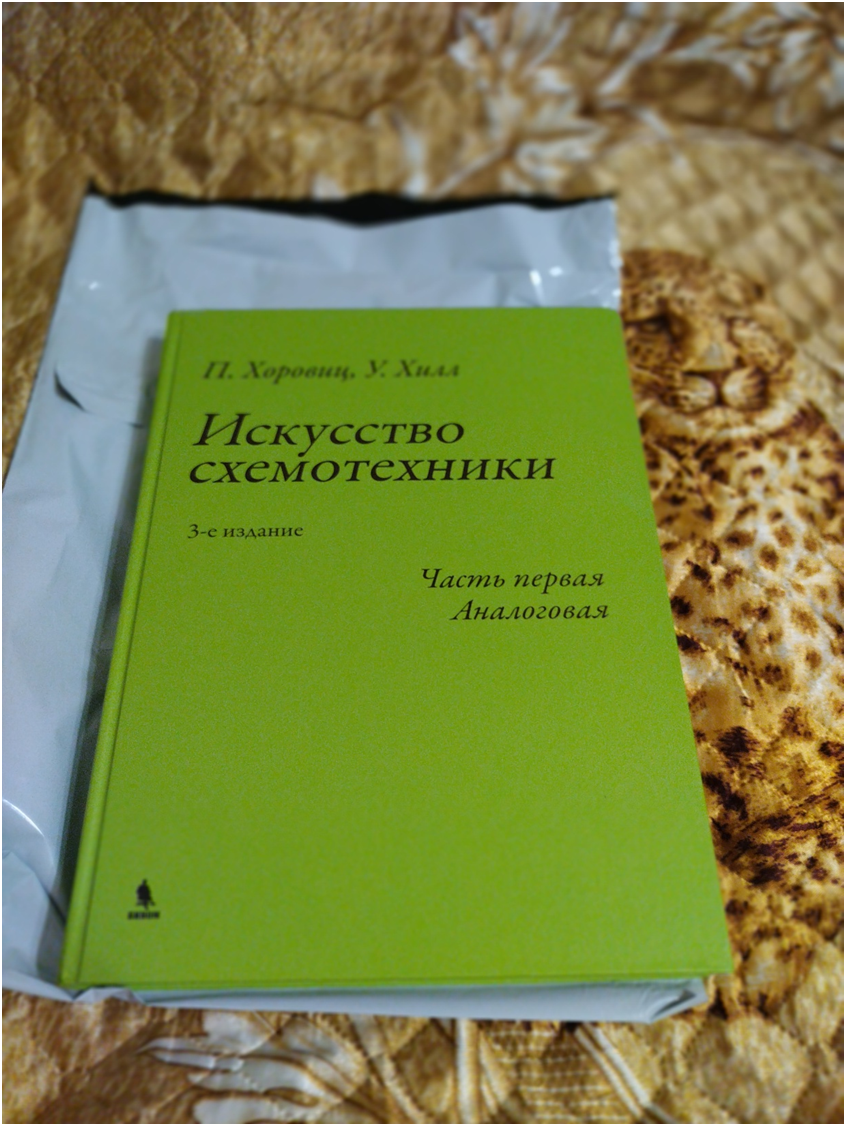review of the Russian version of the third original edition

As I promised in previous articleI present to your attention my independent user review of the new product of this book season: the Russian-language version of the third original edition of the famous book “The Art of Circuit Design”.
Unboxing and appearance
I ordered the book from Ozone (it was a little cheaper than from the publisher directly) and received it a week later. It is well wrapped in a double layer of bubble wrap and secured with tape, so there is no damage. Even though it was in the package. If we compare it with Amazon, where I once ordered the original, our packaging is better. Then the Americans stuffed the book into a fairly spacious cardboard box and carelessly wrapped it with plastic tape made from voluminous air dampers. As a result, the book's cover suffered minor damage during transportation halfway around the world.

Compared to the original book, the format of the Russian version is larger in length and width. The original book wins here only in terms of thickness.


The back cover, for advertising purposes, shows us the entire line of books “The Art of Circuit Design” from the BINOM publishing house.

The orange cover is an incomplete (only nine chapters) domestic version of the second original edition, which continues to be printed. I already mentioned this in the article “How not to get lost in domestic publications of the Art of Circuit Design.” Now the cover bears the inscription “2nd edition”. It just doesn't make much sense. It is necessary to rework the publication and print it in its entirety, and not add another confusing inscription. I doubt that all the “jambs” that I mentioned in the article have been corrected in the publication.
The pale green cover is this book.
The dark green cover is the future book.
It’s a big mystery to me why it’s impossible to title “Volume 1” and “Volume 2,” as the MIR publishing house correctly did in its time.
It seems to me that something else should be printed here, but more on that later.
I was pleased that the cover was made with high quality.
Contents of the book
The first thing you see when you open the cover is an insert with diagrams that were not printed in the book.

To put it mildly, a very controversial decision. But just by looking at it you can tell something about the book.
It was worth gluing the liner in as it keeps falling out. It is very uncomfortable!
The pages in the book are full A4 size. The original book is smaller, the pages are glossy and thinner. This is not a drawback; the printing is on par.
Localization is a problem! The schemes were not adapted to the domestic display format. So they remained in the American standard.
Let's scroll further.
Next, there are two pages with dedications that are “absolutely untranslatable” (if anything, that was sarcasm).


Then there are pages with the title from the original book and the title of the book itself.


The next page contains a technical summary from the publisher. There's a lot of interesting stuff here.

A translation of the welcome page from which the original book begins has been implemented here.

This is where fair questions to translators and publishers begin. The first paragraph is partially translated, and partially contains a “gag”! The translation is not adapted to the Russian language! For some reason they brought in “the age of the authors” here! Then a generally bad translation began. The final phrase “killed” (and it is not in the original at all): “Designed to everyone who is not indifferent to electrical engineering in all senses of its existence.” The “funny” thing is that this particular paragraph is used in the description on Ozone!
The next two paragraphs briefly introduce each of the authors.
When will they stop calling Paul Paul?! As far as I know, he lived in the USA all his life! Would you at least interview Have you looked at it? Complete lack of expertise in the matter! There is no point in putting the names of the authors in brackets, since you have already indicated them earlier!
The final line about Paul is simply a “masterpiece”: “Involved in the controversial
program to search for extraterrestrial intelligence.” Yeah, also tell me that he practices
wrapping foil around your head! Do you think the Arecibo radio telescope is causing
stupid smile?! Winfield also got it in the nuts! I'd better translate it for you
“healthy person” than to list numerous flaws.
Here is the long-awaited third edition of the well-known book “The Art of Circuit Design”. The material in the book has been thoroughly revised, redesigned and updated. This is one of the best and authoritative monographs on electronics design (analog and digital). The previous two editions were translated into eight languages and sold around the world with a total circulation of more than a million copies. The art of circuit design lies in the effective techniques used by designers in practice. This involves a combination of some basic laws, rules of thumb and non-mathematical approaches. This combination allows you to understand how and why a circuit diagram works.
The translation of the remaining two paragraphs can be viewed Here. These paragraphs, in their original form, are available in the public domain on the authors' website.
Personal opinion
It is my deep conviction that the text of this greeting should be placed on the back cover of the book, along with color photographs of the authors.
Also, from the technical annotation we can glean information about the translators. Among others, there is such a shocking entry, perhaps shedding light on such a disgusting translation: “Representatives of the expert community of circuit designers who wished to remain anonymous (Chapter 8, fragments of different chapters).” The meme naturally suggests itself: “What a twist!”
Let's move on to the next page.
And here we have “Preface to the edition in Russian.”

The purpose of this preface is not clear. It's just about nothing! In fact, the editor's foreword should be placed after all the authors' forewords and should not contradict the author's statements! In the original book, “Contents” comes before all prefaces. This is not an essay on a free topic. There is no need to repeat what has already been written in the authors' preface! Recommendations for studying the book should be given here, problems that arise in the process should be described. The book assumes free, independent study at a comfortable pace, and not just consumption of material in “small portions.” It is clear that students are limited in time by the curriculum. The authors also described the audience in their prefaces. And it’s not just students who appear there. I will simply remain silent about the work of translators. CAD modeling is not necessary! This is just a convenient tool that needs to be adequately evaluated. It is not uncommon for the behavior of a model to differ from behavior in real conditions. The reader is not interested in a dubious experience with a disconnected contact and not washed off acid. Such things only indicate a low production culture. About the component base is also not interesting, the book is not about that. “Successful success”, seriously? I wouldn’t stutter at all about the authors’ unexpressed thoughts! It remains a mystery what role the author of this preface played in the fate of the book. The author is clearly not listed as a translator.
Unfortunately, the most important aspect of the book was never revealed!
Let's move on.
Several pages of content follow. I didn’t particularly focus on it, but the translation of some topics definitely raises questions.






Then there is a page listing the chapters of the “second volume,” about which the authors have still not explained anything to the reader. It’s funny that the publisher titled it “Contents of Part 2 (digital).” Clearly an extra page in the book.

The next pages are “Preface to the First Edition.”


This is followed by the “Preface to the Second Edition.”

From these prefaces it is clearly clear that they are from previous editions of the MIR publishing house. The manner and quality of the translation contrast like white on black.
For some reason, the publishers of the book cut out the “legal note” from the “Preface to the Second Edition”!
Finally, we come to the “Preface to the Third Edition.”


I invite the reader to compare the translation from the publisher and mine for themselves. I can only add that the publishing house has eliminated all the footnotes of the authors and the “Addition to the legal certificate” in the preface. Thanks to the comparison, I came to the conclusion that, most likely, the translation was not carried out by a person! Well, a person can’t construct sentences like that!
That's not all! The introductory text ends with a very strange page: “Before you read. Introductory remarks.”

The first point is that they finally explain to us the “grandiose” plans of the publishing house to release the “second volume”, and then about the possible release of a single book. With this approach to business, it resembles the problem of how to make one out of two bricks.
The second point simply “killed”! Seriously, only four books whose titles you can’t even really reproduce?!
The third point tells us which editions of the original book will be on the Russian market. According to the author of the opus, these are the second and third editions. Dear “friend”, I have a surprise for you! On Ozone I found new editions of the first original edition for sale in the form of a two-volume set!
The fourth point states that now we have adopted the American graphic display of elements on the diagram! It’s interesting to look at the decree that legalizes this! There’s some nonsense about “datasheets” and “a unique display of physical quantities a la Horowitz Hill.” This is despite the fact that in the book voltage is denoted by the letter “U”, and not as in the original by “V”.
The fifth point “clogs the bar” and compares electrical engineering with pharmacology in terms of “product range”. Guys, this is some kind of horror and surrealism! I haven’t even gotten to the main content of the book yet, but my eyes are already “bleeding” and I want to slam the cover quickly!
The sixth point brings us nonsense, designed to justify another jamb of editors and translators. Moreover, they make excuses by hiding behind the authors of the original book. “Strongly!”
The seventh point pours oil into the ears on the topic of the unique and untranslatable language of the authors, their humor. Reminds me of quotes from the movie “The Big Lebowski.” A very controversial film! What translation did you look at? If it was broadcast on central television, then it is not funny at all. And if it’s the one that’s funny, then it’s better not to mention it in vain. Another ridiculous display of incompetence.
And all this without any signature! Convenient, no personal responsibility.
Finally, the book itself begins.
I haven't read everything. I looked at the first three paragraphs. I looked at the “control points” in the middle. I looked through the applications. The publishers included the “legal certificate” at the end of the book in a slightly modified form. On a quick look I saw the following:
· all kinds of errors in the Russian language;
· clumsy machine translation;
· technical nonsense;
· violation of the sequence of presentation;
· numbering violation;
· missing text fragments;
· missing author footnotes.
Conclusion
Sad result. After almost eight years of waiting, domestic readers are officially presented not with a translated book, but with a “piece of waste paper” that discredits the honor and dignity of the authors (to paraphrase one quote from the movie “The Big Lebowski”)! Moreover, for an impressive price tag! The cover designer got it right with the color! The book is not ripe!
If we compare it with the latest edition from the MIR publishing house, the difference becomes obvious. I remember with warmth the rich and capacious Russian language of that book. BINOM publishing house should learn from its predecessors! So far, the publishing house does not seem to take the matter seriously. They continue to reinvent the wheel behind closed doors, which is terrible and no one needs.
It's a shame about the book! There are many books, even within any narrow field of human activity. But among them there are not many “guides” who can clearly explain basic things and do it consistently. This is how systemic knowledge is formed that will never be forgotten. The Art of Circuit Design is just such a book.
The book did not appear out of the blue (article)! At that time, there was a personnel shortage in the electronics industry in the United States. Scientists from other fields of knowledge needed to understand electronics in order to create new devices themselves or at least competently draw up technical specifications for their production. If we draw historical parallels, then this is what any engineer needs in today's realities. Especially in developing countries. Not “everyone,” however, realizes this even in the most difficult conditions of external economic pressure! The recent Philippine President Marcos, for example, knew a lot about science and technology (article). The same cannot be said about our political contemporary, D. A. Medvedev. Whoever does not develop electronics in the modern world is a “loser” who risks his resources and his head!
All the conditions have long been in place for the domestic version of the book to become even better than the original. There are normal translations by enthusiasts, many typos in the original have been identified, and even all the exercises for the first chapters of all original editions have been solved (link)! But official publishers continue to stubbornly create wild things. It seems like they don't understand who their target audience is. They seriously believe that professionals waited until they translated the book to become familiar with the current American electronics industry nomenclature and prices. And the “Easter eggs” from the movie “The Big Lebowski” are not the main thing in the book, as the authors say in plain text (article).
Do you know what the “back door” of the BINOM publishing house looks like?

The idea is not bad if the product is of sufficient quality. Otherwise, such a solution does not arouse enthusiasm among the reader. Who would like to “galvanize a dead horse” at their own expense and in their free time? Moreover, there is no feedback like the authors on the site.
So far, something like this. Let's wait and see what happens next.
Thank you for attention!
I express my gratitude to subscribers groups in VKwhose donations were used to purchase the book for review.
According to good tradition, Alexandra Plath is proclaimed the muse of this article. Anniversaries don't happen very often.





